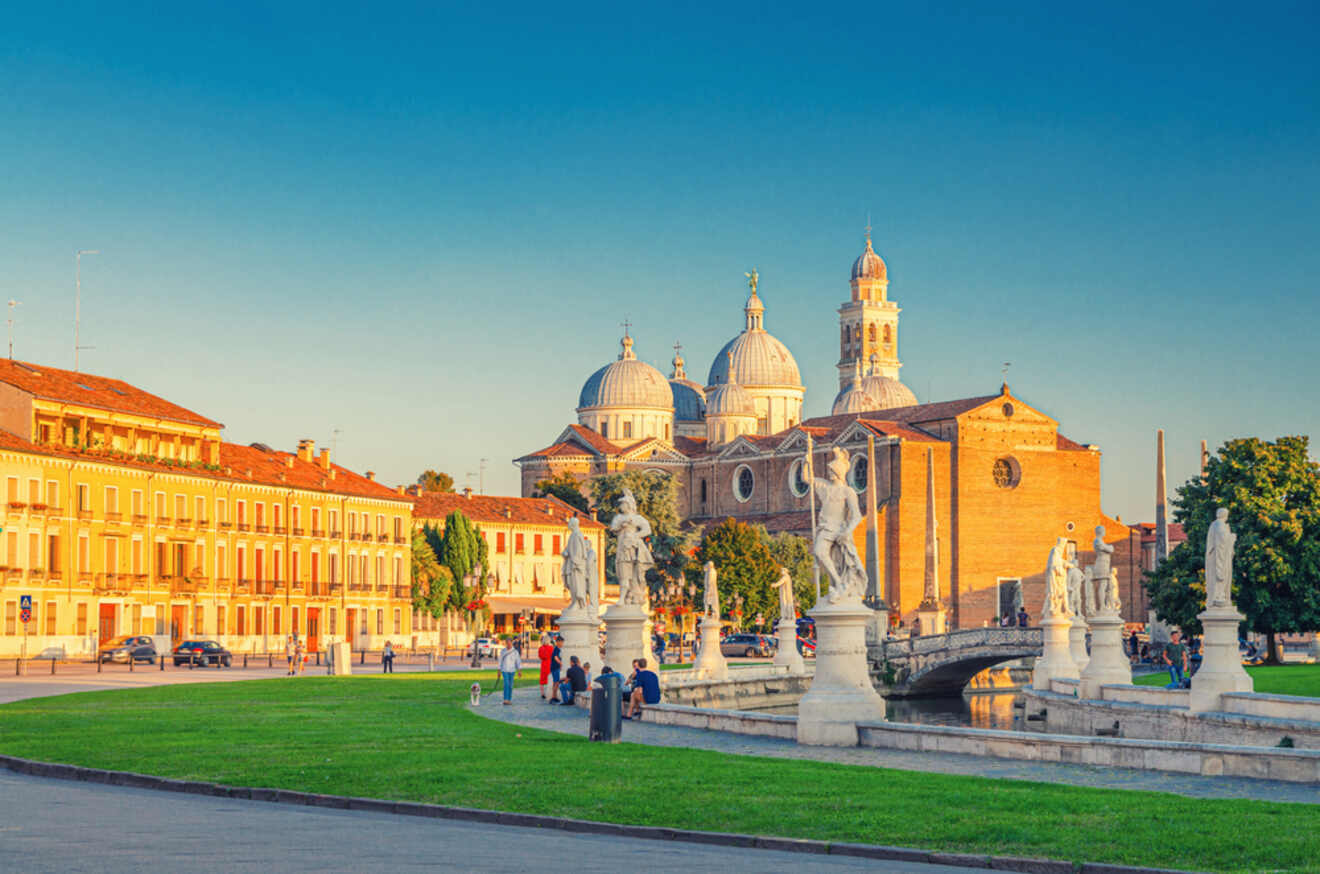
Welcome to this guide on the best things to do in Padua! Even though this is a small town in Northern Italy, you’ll be surprised by how many attractions and sights there are to visit.
From amazing Italian architecture that sparked the Renaissance, to the second oldest university in Italy, plus amazing food, there is so much to see and do in Padua.
The great thing about this quaint little town is that you can check out all the main attractions in just one day because everything is within walking distance! I visited it for a day by train from Venice and then continued on to Vicenza for a 7-day trip around the Veneto Region.
However, if you have more time to spend in Padua, there are also many other amazing things that I’ve included in this article.
So check out this list of the 14 best things to do in Padua to help you organize your visit! At the end, I’ve also included practical info about how to get to and around Padua, and where to stay in this charming Italian town.
Quick Picks for Your Stay
Don’t have much time to spend reading this article and you need to book something quickly? Then check below to see the 3 best things to do in Puglia and the top 3 hotels!
Here are the best tours to book in advance:
- Take a private to see the Scrovegni Chapel
- Explore the piazzas on a walking tour
- Discover the story of the Jews in Padua
And here are the best hotels: Casa Giotto (luxury), Hotel Patavium (mid-range), Elena Casa Turistica (budget)
Contents
- Quick Picks for Your Stay
- 1. Visit the Scrovegni Chapel: A masterpiece of art
- 2. Dive into the wonders of the Basilica of Saint Anthony of Padua
- 3. Wander through the enchanting Padua Botanical Garden
- 4. Relax at Prato della Valle: Italy’s largest piazza
- 5. Eat the best gelato in the world on the city’s most famous street
- 6. Gaze at the frescoes at the Padua Cathedral
- 7. Enjoy the delicious food at Palazzo Ragione
- 8. Have a taste of history at Caffe Pedrocchi
- 9. Experience the vibrant Padua markets and piazzas
- 10. Savor Padua’s street food and local delicacies
- 11. Visit Padua University: the second-oldest university in Italy
- 12. See the stars at Specola Observatory: A lesson in astronomy
- 13. Learn about the story of the Jews in Padua in the Jewish Ghetto
- 14. Cycle or cruise on the Brenta Canal
- How to get to and around Padua
- Where to stay in Padua
- FAQs about things to do in Padua
- Conclusion
1. Visit the Scrovegni Chapel: A masterpiece of art
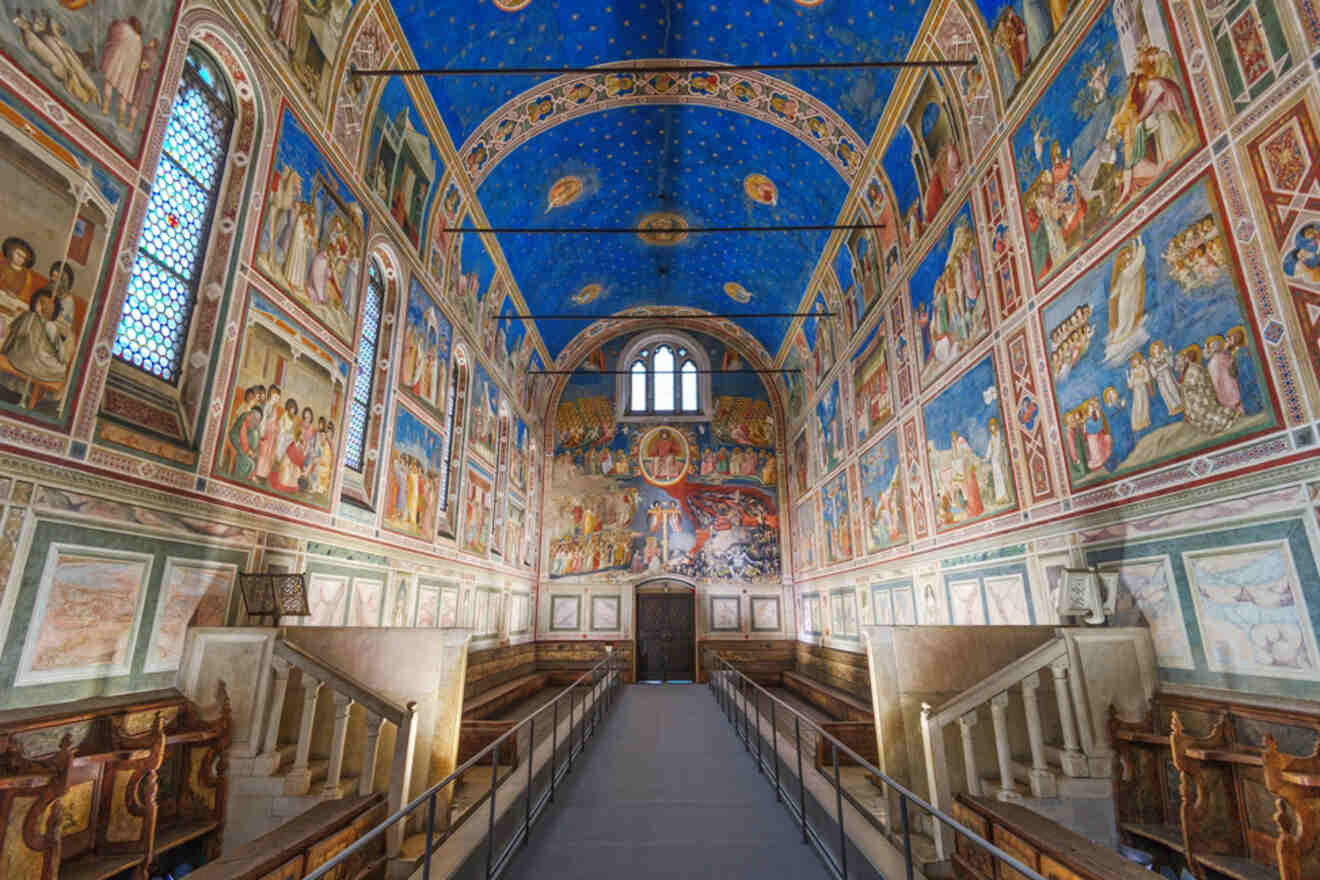
When you step off at the train station, the first thing you MUST visit in Padua is the Scrovegni Chapel (Cappella degli Scrovegni). It’s just a short 10-minute walk away.
This chapel, built in the 14th century, is one of the eight buildings of Padua’s UNESCO World Heritage Sites known as Padua’s Fourteenth-Century Fresco Cycles.
Commissioned by Enrico Scrovegni, who used it as his private family chapel, the church looks pretty simple on the outside. But, when you walk inside, be prepared to be awestruck!
Standing under the ceiling painted in blue scattered with gold eight-point stars, your eyes will then look at the walls and follow the Biblical story of Jesus of Nazareth depicted in chronological order in the 38 horizontal cycles.
These stunning frescoes were painted by the renowned Italian painter Giotto together with over three dozen other painters.
It is said that it was Giotto’s work in the Scrovegni Chapel that ignited the Italian Renaissance.
The most important thing you need to know about this chapel is that it can only be visited with pre-booked tickets, and they sell fast. So make sure that you pre-book your ticket as soon as you know when you are going to be visiting Padua, or at least a day in advance because you can’t buy tickets for the same day (this is why we didn’t get to visit this amazing chapel 🙁).
Another option is to visit the chapel with this great private walking tour. This will take you on an incredible almost 3-hour journey around Padua, including the Scrovegni Chapel (and it includes an entrance ticket to the Scrovegni Chapel).
TOUR PRICE: from €130
2. Dive into the wonders of the Basilica of Saint Anthony of Padua
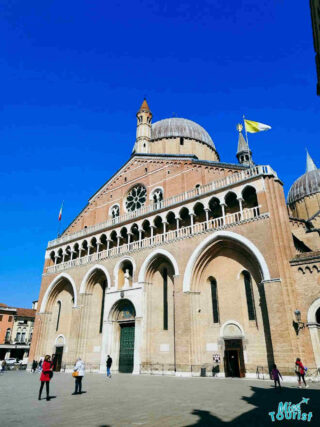
Maybe we didn’t get to see the Cappella degli Scrovegni (there’s always next time, right?), but I am so happy that we got to visit the astonishing Basilica of Saint Anthony of Padua (map).
Also known as Basilica di Sant’antonio, or as the locals call it “il Santo”, this church is Padua’s biggest and most important religious site, dedicated to the city’s very own patron saint.
Initially, it was built as a small chapel to house the remains of St Anthony after he was canonized, but today it has evolved into an enormous basilica. We spent at least an hour roaming around and exploring the place.
The church is acknowledged as one of the eight international shrines recognized by the Holy See and is a famous pilgrimage destination. Every year, especially around the time of the June 13 Feast, millions of Roman Catholics from around the world travel to Padua to visit it.
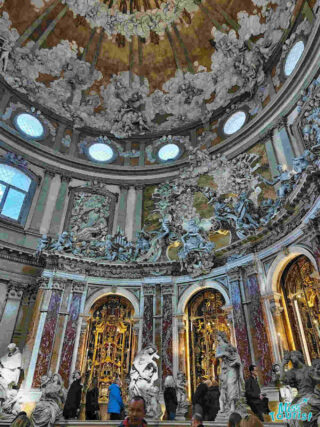
The church’s exterior was modeled on St. Mark’s Basilica in Venice, incorporating Byzantine domes, but the interior is mostly Gothic with elements of Baroque.
There’s so much to explore inside, and the best thing about it is that most of it is completely FREE to visit!
The weirdest thing you can see in the Basilica is St. Anthony’s remains in glass boxes in one of the chapels, including his tongue still attached to his lower jaw.
There are also many gorgeous frescoes and artworks by famous Italian artists. Still, probably the most important ones are Donatello’s statues, including the bronze Madonna and Child and six other statues of saints.
If you want to know more about St. Anthony’s life and admire more artwork by renowned Italian painters of the 14th century, you can visit the Museums of the Basilica and the Oratory of St. George and the School of the Saint for a small fee.
Subscribe here to get up to 35% off your accommodation for your next trip!
3. Wander through the enchanting Padua Botanical Garden
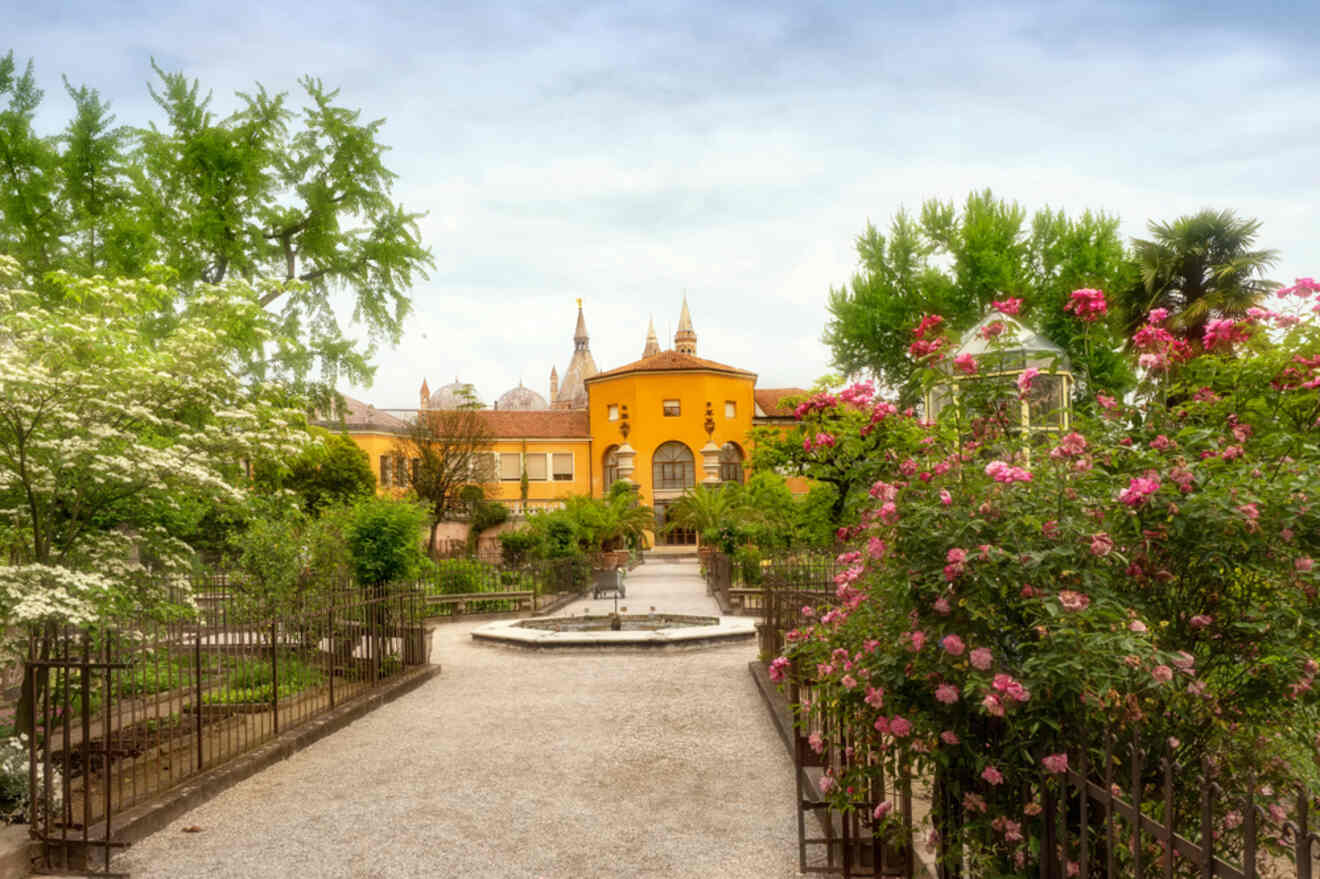
Known in Italy as the Orto Botanico di Padova, Padua’s Botanical Garden is another UNESCO World Heritage Site in this city. You might wonder why a botanical garden is recognized as a UNESCO World Heritage Site.
Well, the Padua Botanical Garden is the oldest botanical garden in the world still in its original location. It is believed to be the predecessor of other amazing botanical gardens around the globe.
Founded in 1545 by the Venetian Republic, the initial purpose of the garden was to grow medicinal plants. Today, the garden is linked to the University of Padua and is used as part of the studies.
There are more than 7,000 botanical specimens and 3,500 different varieties of flora. One of them is a 400-year-old palm tree!
There are two parts of the garden. First is the Historical Garden, which is, in fact, the original garden as it was first set up back in 1545. The second is the Biodiversity Garden, located in a glass house with five different natural environments.
The garden is open from 10 AM to 7 PM latest, and you should get your ticket online (even though you need to select visiting times, you can go at any time during opening hours).
TICKET PRICE: €10 for adults, €6 for young people between 16-25, and free for kids aged 6-12
4. Relax at Prato della Valle: Italy’s largest piazza
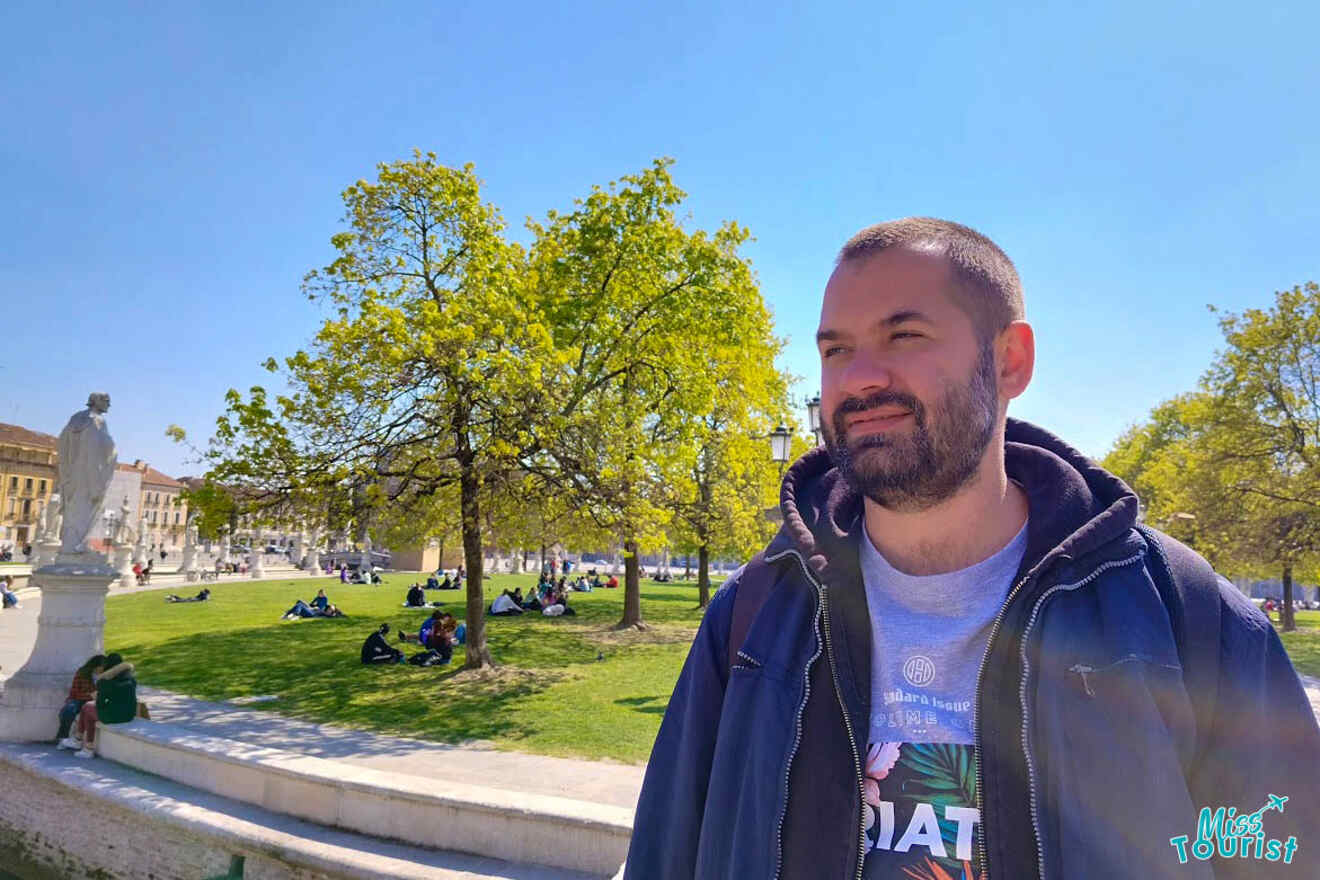
Welcome to the 7th largest square in Europe and the largest one in Italy. That’s right! Even though Padua is one of the smaller towns in Italy, it houses the largest square in the country.
Pratto della Valle stretches on an impressive 90,000 square meters (a million square feet) elliptical-shaped area.
The square also boasts impressive architecture and unique design. In the middle of the oval-shaped square, there’s a beautiful green space, with a canal around it that has statues on both sides, exactly 78 statues of people important to Padua. For instance, you’ll come across a statue of Galileo Galilei, who once said that he lived and taught in Padua for the happiest 18 years of his life, as well as a statue of the renowned humanist and poet Petrarch who often visited Padua.
In the past, Prato della Valle used to be a Roman theater and a horse racing club, but now it’s a great place for both locals and tourists to take strolls, relax, sunbathe, and attend events.
If you are interested in learning more about the history of Italy’s largest square and the 78 statues, you should take this 2.5-hour walking tour around Padua.
TOUR PRICE: €172 per person
Join a Padua City walking tour
5. Eat the best gelato in the world on the city’s most famous street
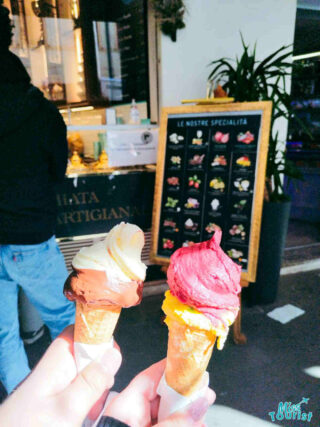
Ready to try the best gelato in the world? I know that this is a subjective opinion, but I have tried many gelatos in my life, and I still remember the taste of the most amazing gelato I’ve had in the world! And it was right here in Padua.
Gelateria Portogallo (map) is a small but very famous gelateria in the heart of the city located on Via Umberto I, the best place to visit if you want to feel the local life in Padova.
On workdays, the gelateria works from 2 PM and since we were there on Thursday, we still had to wait 30 minutes in line once it opened (even though we stood in line at about 1 PM).
They serve lots of basic flavors but also have about 20 special flavors which change from time to time. My husband had dark chocolate and Zamboni, and I had pomegranate and some special flavor with vanilla, wine, and saffron. They were out-of-this-world delicious!
6. Gaze at the frescoes at the Padua Cathedral
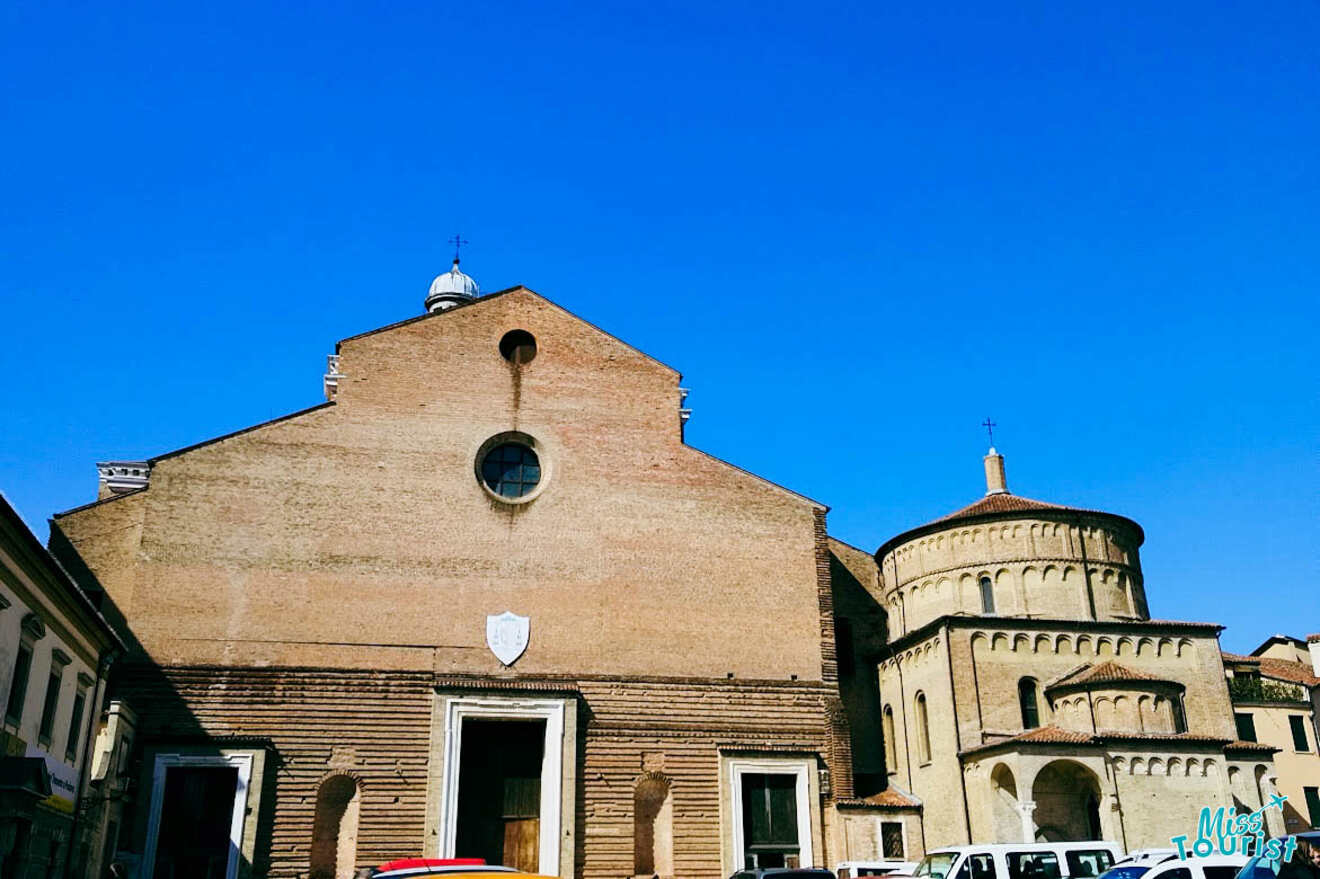
Piazza Duomo (map) is one of the most important squares in Padua because it houses three very important buildings.
First is the Padua Cathedral, also known as Basilica Cattedrale di Santa Maria Assunta, which dates back to 1117, but it had to be rebuilt many times because of earthquakes. As a consequence, the exterior of the cathedral remains unfinished today.
However, the inside is pretty gorgeous and a bit different from all the other cathedrals I’ve seen in Italy. The walls are mostly white but there are many beautiful frescoes and artwork displayed all around.
We visited during some kind of Easter mass, and even though we couldn’t walk around out of respect, the mass made it an even more amazing experience.
However, the other two buildings next to the cathedral are unmissable.
The first one is the Baptistery where you will see one of the most precious fresco cycles of the 14th century painted by Giusto de Menabuoi, which is yet another UNESCO World Heritage Site in Padua.
The second one is the Diocesan Museum, located in a 15th-century building that once served as the home for Padua’s bishops, and features an impressive collection of religious artwork. The highlight here is the Bishops’ Hall, which has wall paintings showing the first hundred bishops of Padua.
The best way to explore all these places is with a guided tour, and I found just the right one for you! During this tour, the narrator will guide you and teach you something more about the importance of these three buildings.
PRICE: €12 per person
7. Enjoy the delicious food at Palazzo Ragione
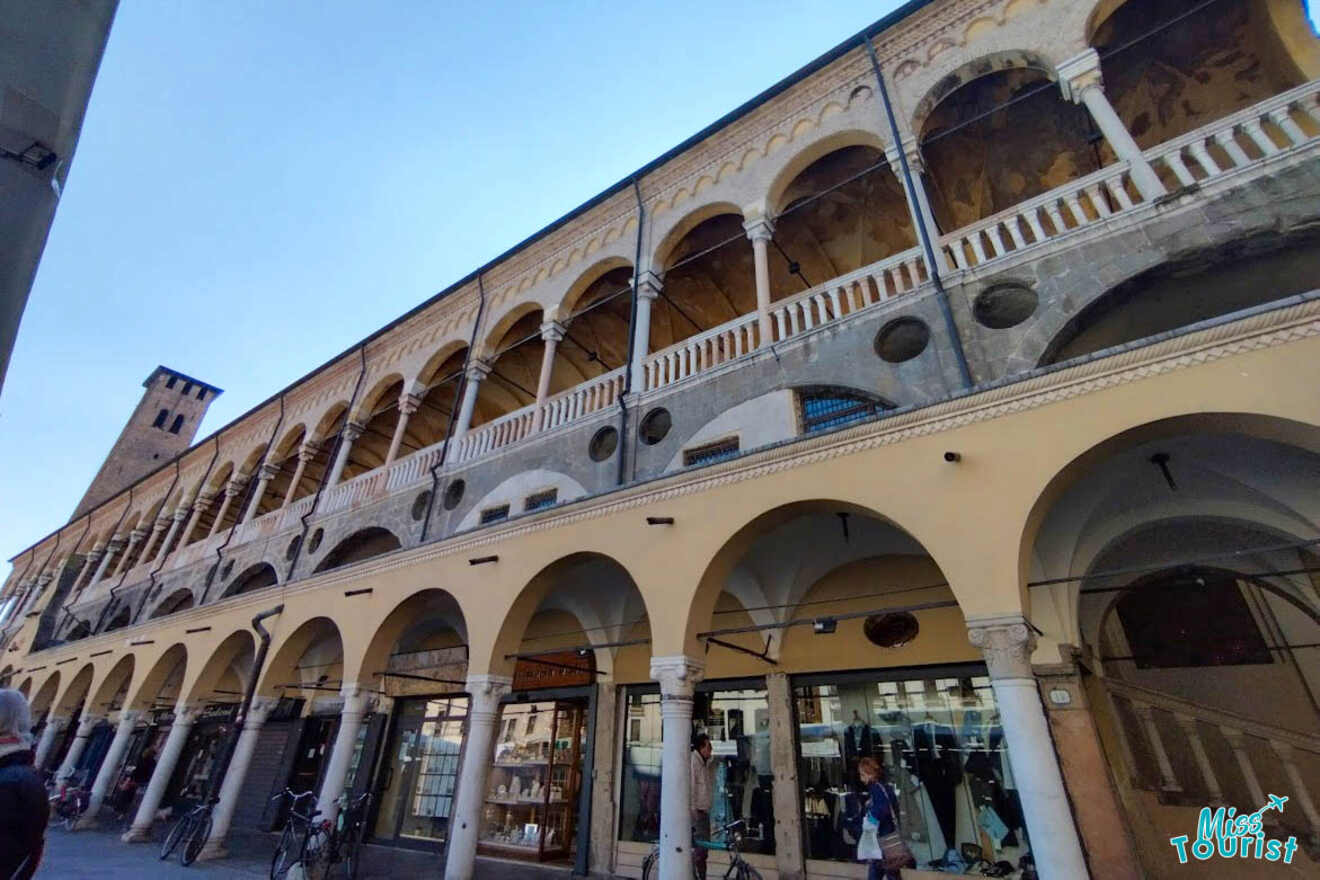
Nestled between Piazza della Frutta and Piazza delle Erbe is the Palazzo Ragione (map). Built 1218-19 as a law court, today it functions as a market on the ground floor, and museum on the upper one.
Palazzo Raggione is, in fact, Europe’s largest medieval hall.
The hall’s main floor has many beautiful paintings, statues, and the famous wooden horse, which is a copy of Gattamelata’s horse in Donatello’s famous statue in the Piazza del Spirito.
This palace is also the perfect place for foodies since the vendors sell all kinds of Italian delicacies.
If you’re looking for a great place to have lunch here, I highly recommend Pastasuta (map). They make their pasta fresh each day and you can create your own dish by choosing between the pasta type and the sauce to go with it.
But if you are up for it and have the time, you can try out this combo of a market tour and cooking class. You will visit the markets where you’ll pick up the ingredients for your meal, after which you’ll go to the host’s place to make a pasta dish and tiramisu, accompanied by delicious Italian wine.
PRICE: from €149 per person
8. Have a taste of history at Caffe Pedrocchi
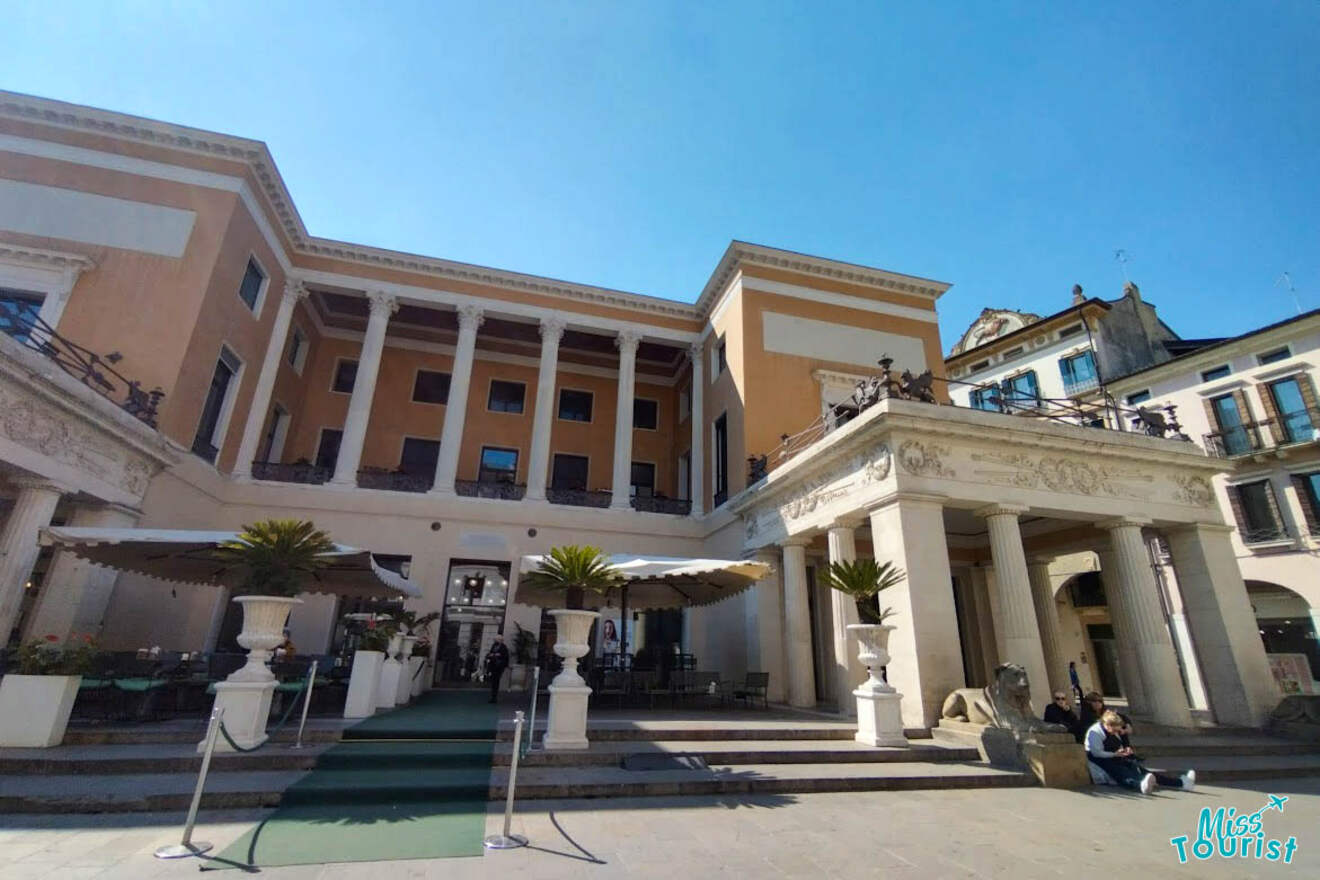
When it’s time to stop for coffee in Padua, there’s no better place than Caffe Pedrocchi (map). Located in the heart of Padua’s old city, this cafe is not just a regular coffee shop, but it has so much more meaning to the people of Padua.
In the past, it was known as ‘the cafe without doors’ because from 1831 until 1916 was open 24/7, and since its doors never closed that’s how it got the nickname.
Apart from serving guests all the time day and night, it became quite a famous meeting place for intellectuals, academics, and politicians. It was also a place for grand events and parties.
Today, you can have a cup of coffee and pastry from their on-site pastry shop while admiring the beautiful design of the interior. Besides having a regular cup of joe, you should try their signature Caffè Pedrocchi – a delightful espresso made with 100% Arabica coffee, topped with mint-infused cream, and a dusting of cocoa powder.
If you want to learn more about the historical significance of this place, for a small fee you can visit the upstairs Museum of the Risorgimento and of the Contemporary Age.
If you are interested, you can combine a cup of coffee in Caffe Pedrocchi with a guided walking tour around the city with this tour. For 1.5 hours you’ll explore the city, learning everything there is to know about its history, and then have a chance to discuss your impression over coffee and biscuits at Caffe Pedrocchi.
TOUR PRICE: from €33 per person
9. Experience the vibrant Padua markets and piazzas

There’s no shortage of amazing markets and piazzas that you must explore when in Padua.
I’ve already mentioned to you the foodies’ heaven, Palazzo Ragione, located between Piazza della Frutta and Piazza delle Erbe. Well, besides hugging the Palazzo, Piazza delle Erbe also hosts Padua’s oldest market (map).
Padua’s main market has been running for over 800 years across Piazza delle Erbe and Piazza delle Frutta, every morning from Monday to Saturday.
You’ll find stalls with fresh vegetables and fruit, artisan Italian cheese, and mouth-watering herbs and spices sure to make any dish amazing.
Nearby, on Piazza dei Signori, you’ll also find a market where you can get clothes, bags, accessories, and other stuff. This market operates during the day, but at night the square turns into a local meeting place to have dinner or a cup of coffee at the surrounding restaurants and cafes.
Besides the market, you must also visit Piazza dei Signori (map) so that you can see the clock tower with its astronomical clock. This clock is a bit special for a few things: it is one of the oldest clocks in the world still in working order, built in 1344; it has a 24-hour dial, instead of the usual 12 hours; and the Libra zodiac sign is missing, with many theories why that’s so.
If you want to learn more about interesting facts, I suggest that you take a private walking tour of Padua. During the 2-hour-long private excursion, you’ll not only visit the most important attractions, but you’ll also see and discover some hidden corners of the town, together with its myths and legends.
TOUR PRICE: from €125 per person
Book your private walking tour
10. Savor Padua’s street food and local delicacies
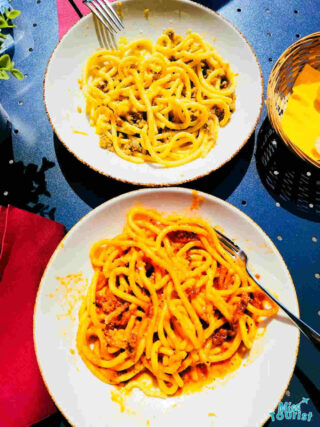
Italy is known for its food all around the world, and each region, even each city has its own dishes and foods that are specific to that place.
So when you are in Padua, you’ve got to try the typical local dishes there:
- Bigoli with duck ragu: Bigoli is a signature pasta shape in Padua, and’s like a combination of spaghetti and rigatoni. We had this at Pastasuta and it was delicious (also had Bigoli with Amatriciana).
- Risotto coi rovinassi or fegatini: A hearty risotto made with chicken livers, hearts and gizzards, onions, and spices, often served with grated Grana Padano cheese.
- Oca in onto Padovana: Goose meat cooked with herbs, and a little red wine preserved in goose fat (it’s also rare to find nowadays).
For breakfast, you can’t go wrong with the usual Italian espresso and a croissant, but if you want to try something else you can also have a cup of the Padovan coffee with mint and try brioche au sucre, a sweet brioche patty sprinkled with sugar flakes.
11. Visit Padua University: the second-oldest university in Italy
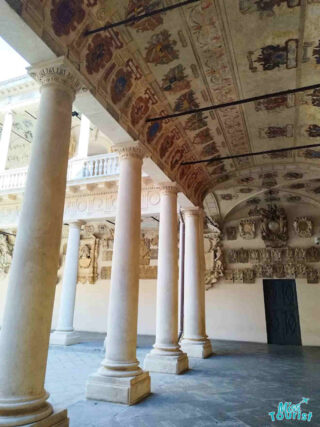
Established in 1222, the University of Padua is the second-oldest university in Italy and the fifth-oldest one in the world. The university was started by a group of scholars and professors from the University of Bologna (the world’s oldest university) who wanted more freedom in their academic pursuits.
Did you know that the first-ever woman to earn an academic degree, Elena Lucrezia Cornaro Piscopia, graduated from the University of Padua in 1678?
The best way to immerse yourself in the history of the university is to visit its main campus, Palazzo Bo. You can explore the outside courtyard, with its many amazing frescoes, for free, but to visit the inside you must take a guided tour.
On the tour, you’ll get to see the Aula Magna (Great Hall) where Galileo held his lectures, and the world’s first permanent oval anatomic theater where students learned anatomy by witnessing dissections.
12. See the stars at Specola Observatory: A lesson in astronomy
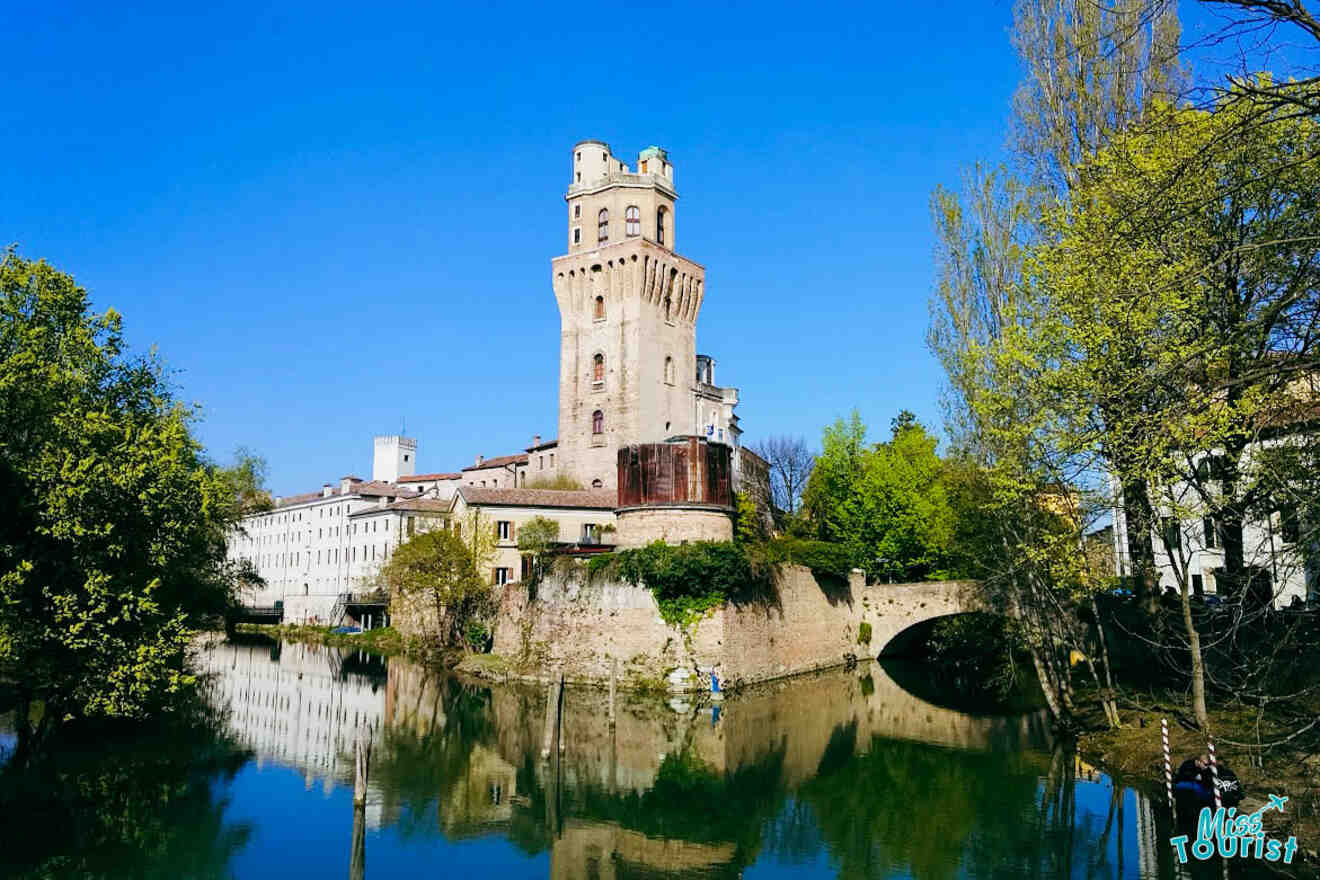
There’s also one more location at the University of Padua that is worth visiting, and that is La Specola. Originally a tower of an ancient castle, then transformed into the Astronomical Observatory in 1777, today, it serves as a museum showcasing globes, telescopes, and various instruments.
This attraction is not so well-known among tourists visiting Padua, however, it’s still one you shouldn’t miss if you have the time to visit.
There’s a lot of history entwined among the walls of this 14th-century tower. Legend says that it was here that Galileo made his discoveries, but that cannot be true since the tower was constructed 150 years after Galileo moved from Padua to Florence.
However, from that time until today, many international researchers have visited La Specola and made their astronomical research and discoveries here.
To visit the tower you will need to reserve your time spot and then purchase the ticket at the entrance. Keep in mind that you can only visit on the weekends or public holidays. The price is €8 for adults, and €5 for children up to 14 years of age.
NOTE: Because of its structure, it’s not suitable for those with walking difficulties.
13. Learn about the story of the Jews in Padua in the Jewish Ghetto
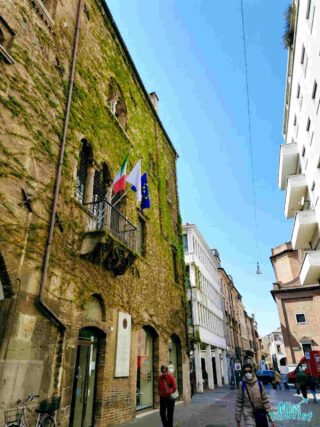
Padua also has a rich Jewish history that’s worth getting to know, since it was a major place for Jewish learning, with a famous Rabbinical Academy that students from all over Europe attended. Additionally, at that time, Padua Medical School was the only one that allowed Jewish students.
Like many other cities around the world, Padua also has its own Jewish Ghetto. This area is located right next to Piazza delle Erbe, and it resembles a labyrinth of narrow, cobbled streets. The Jews were settled here in the 13th century, however, it was established as a ghetto in 1601.
Here you’ll find a few important synagogues and many little shops and boutiques where you can try Kosher cuisine.
But the most important attraction you should visit here is the Jewish Heritage Museum of Padua where you’ll have the chance to explore Padua’s Jewish history and learn about events and rituals of the Jewish community from its origins to today.
NOTE: The Museum (and the Italian Synagogue which is part of it) are only open on Sundays from 10 AM to 6 PM if you want to visit by yourself. However, it is possible to visit on other days as well with a guided tour.
TOUR PRICE: €12 per person on Sundays, €12 per person with a max of 5 people per group on other days (you can be less than 5 people, but you’ll still have to pay the full €60)
14. Cycle or cruise on the Brenta Canal
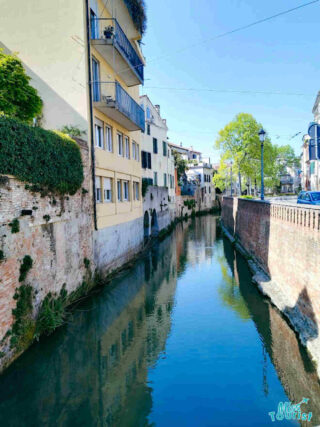
Water was one of the most important ways to transport goods and people in this region. Being that way, all the major, and even minor cities needed a better way to be connected with the other parts of this region.
Therefore, in the 15th century, they built the Brenta Canal, stretching from Chioggia on the coast to the Brenta River in Padua.
Venetian aristocrats saw this as an opportunity to build summer residences on the shores of the river to be more secluded and further away from the major cities.
Today, you have the opportunity to follow the waterway that many locals had to go through to transport goods or travel to another city, as well as enjoy a glimpse of the opulent villas that line the river.
This is the only thing to do in Padua that is not located in the heart of the city (yet it starts there), but it’s a great experience that I just had to share with you. So, if you are visiting Padua for more than one day, it is a must-do!
And, if you are planning to visit Venice next, or you are coming to Padua from Venice then I recommend that you do it with this boat cruise that connects both cities. During the cruise, not only will you have the chance to enjoy the landscapes surrounding the canal, but you’ll also get the chance to visit some of the most beautiful villas on guided tours.
TOUR PRICE: €129 for adults, €59 for children between 6-17, and free for kids under 5
| 🏛️ Best museum: | Specola Observatory |
| 🎢 Top paid attraction: | Scrovegni Chapel |
| 🚶🏽♂️ Best free activity: | Saint Anthony of Padua Church |
| 🕺 Nightlife: | Via Umberto I |
| 🥟 Must-try food: | Bigoli with duck ragu |
How to get to and around Padua
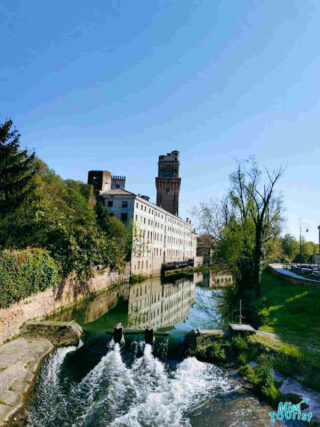
Even though Padua is a significantly smaller city compared to the other major Italian cities, it is still well-connected with the other parts of the country.
If you are planning to visit Padua and you want to arrive by plane, the closest airports are Marco Polo in Venice (20km) or the Treviso Airport (70km). We landed at the Treviso Airport, and first visited Venice, then went to Padua.
From Venice to Padua we traveled by train. I highly recommend using TranItalia, but ItaliaRail is also another great company. The trains in Italy are relatively cheaper than the other means of transport compared to the length of the journey.
However, if you are going to do like we did and visit Padua from Venice, you can also do it by boat and have the chance to experience the Brenta Canal as well.
Another great way to get to and around Padua is to rent a car, but you have to keep in mind that Padua has Limited Traffic Zones in the city center, so if you are going to use the car to move around make sure you know where you are going to park beforehand.
However, in Padua, you can reach everything on foot. The city is relatively small and you can easily walk anywhere. But if you don’t feel like it, you can also take advantage of the hop-on-hop-off bus with a 24-hour ticket that allows you to get on and off the bus as you please.
Where to stay in Padua
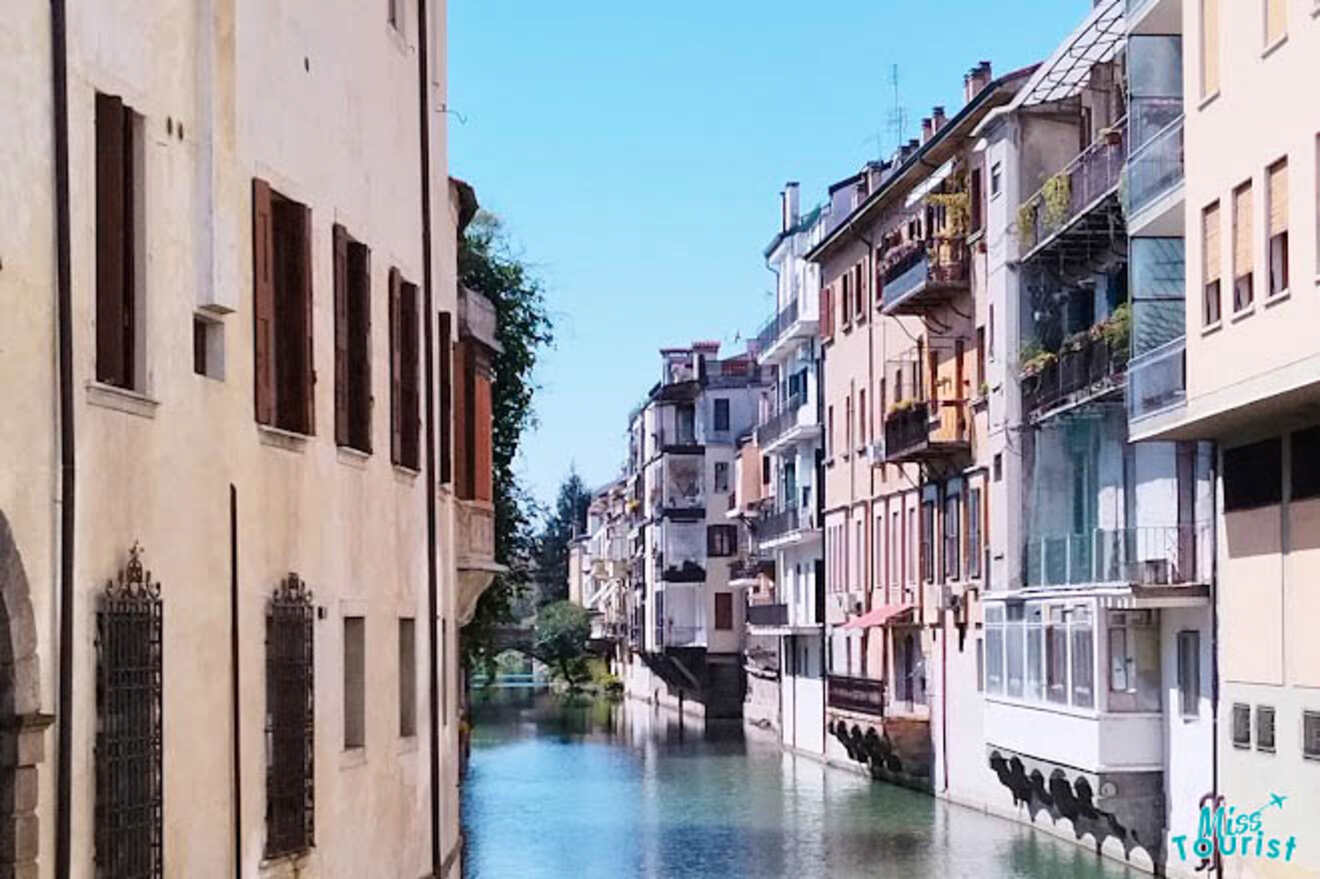
If you are planning to stay in Padua, let me make things simpler for you and recommend some awesome accommodations. There are many amazing places to stay in Padua, but for you, I’ve handpicked the 3 BEST ones according to their price range:
- Luxury (from €170 and up): Casa Giotto – Located in the heart of the city, this guest house is the perfect luxury stay! There are many room types available, all equipped with a flat-screen TV, a private bathroom, and air conditioning. There is also a private garden where guests can relax!
- Mid-Range (from €120 to €170): Hotel Patavium – This hotel has so many cool amenities that you’ll want to stay here forever. First, there is a private garden with a glass terrace where you can have a varied breakfast buffet. Secondly, you can choose from the different room types, including an elegant suite with a jacuzzi. Lastly, there’s free parking if you are coming by car. What more do you need?
- Budget (up to US€120): Elena Casa Turistica – This large apartment has everything you need for a comfortable stay, from a fully equipped kitchen to a balcony with garden views. There’s also a private entrance to ensure maximum privacy during your stay.
FAQs about things to do in Padua
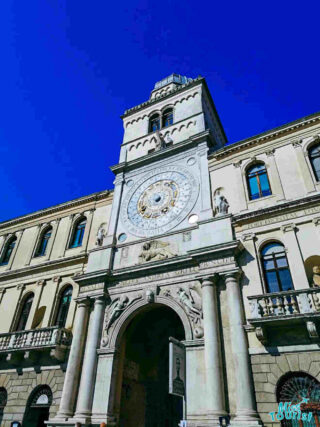
📅 How many days do you need to see Padua?
Since it’s a relatively small city, you can see the major attractions in one day. But if you want to explore Padua fully, I recommend staying at least 2 days.
🚶 Is Padua walkable?
Absolutely, you can walk almost anywhere in Padua given its small size.
🏛️ What not to miss in Padua?
There are two major attractions that you mustn’t miss in Padua. The first one is the Scrovegni Chapel and to visit it I recommend you go on a guided tour. The second one is the Padua Cathedral which is completely free of charge (except certain areas of the cathedral).
✨ What is Padua known for?
Besides the basilicas and cathedrals, Padua is also home to the second-oldest university in Italy, and the world’s oldest academic botanical garden.
Conclusion
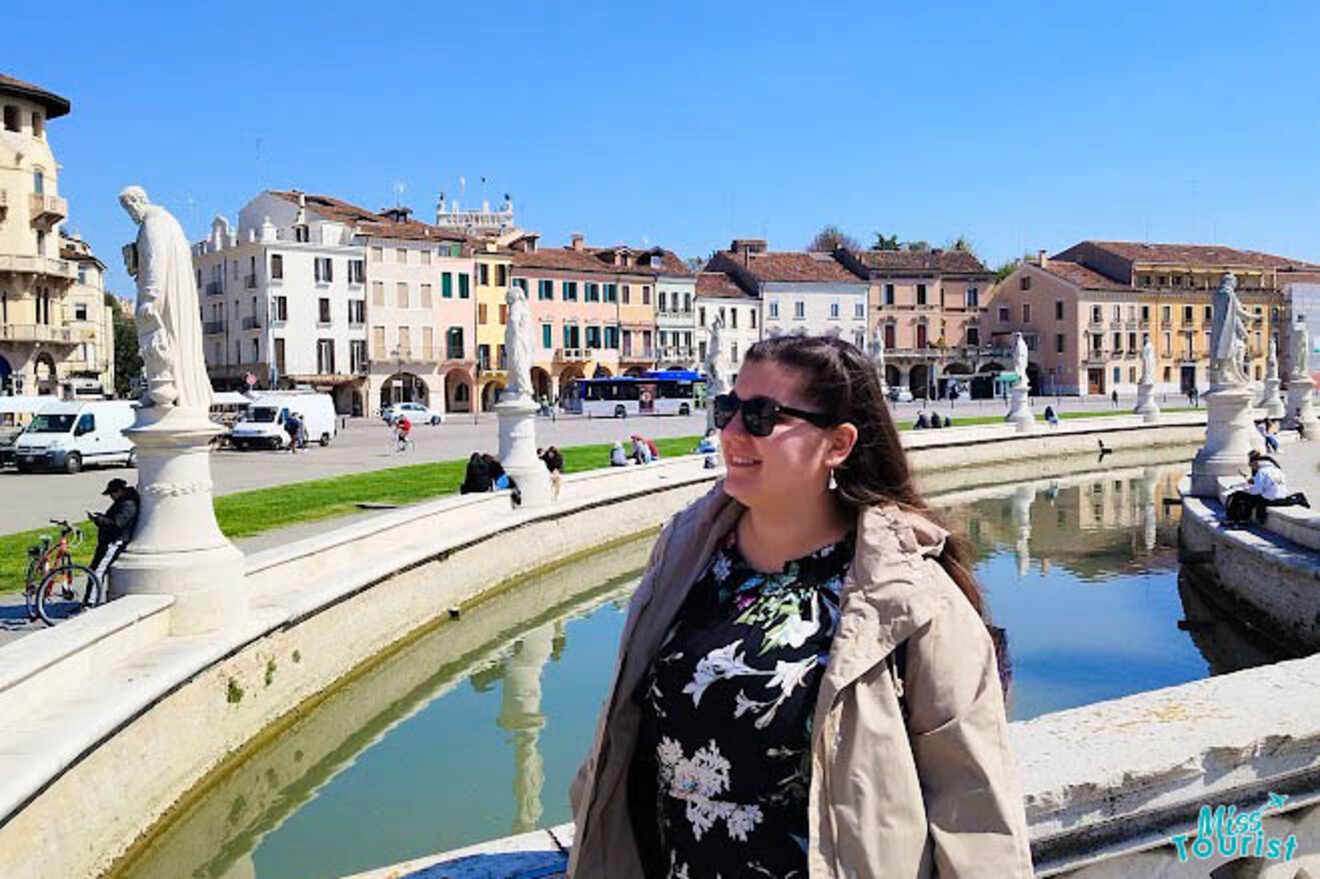
You’ve reached the end of my guide on the best things to do in Padua, Italy. I hope that you have found the information useful and now you have plenty of ideas on how to organize your visit.
I loved visiting Padua (even more than visiting the major cities in Italy) and I fell in love with its small-town charm and rich history. I am sure that you will also have an amazing time in this captivating city.
If you have any questions about your trip to Padua, please leave a comment and I will make sure to get back to you!
Have a great time in Padua,
Marija
Pin it for later!
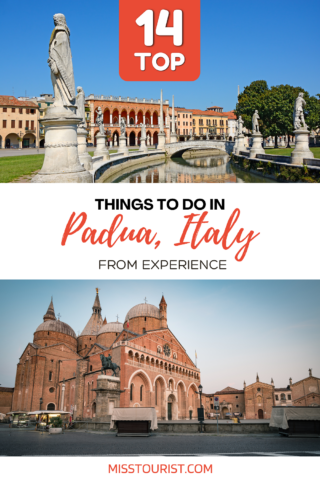
Pin it for later!
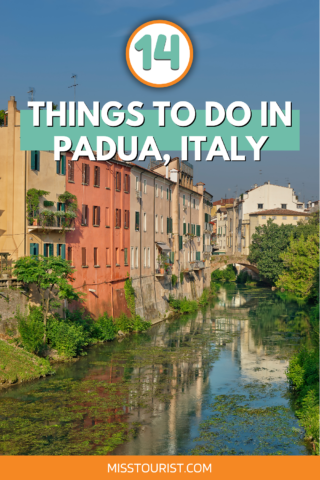

 Marija Petrushevska
Marija Petrushevska 







This site is protected by reCAPTCHA and the Google Privacy Policy and Terms of Service apply.